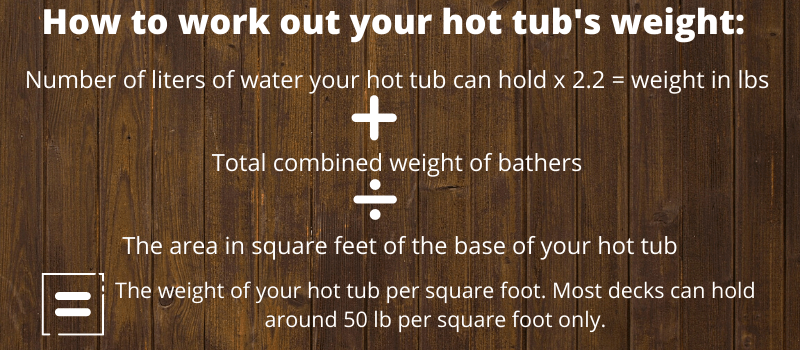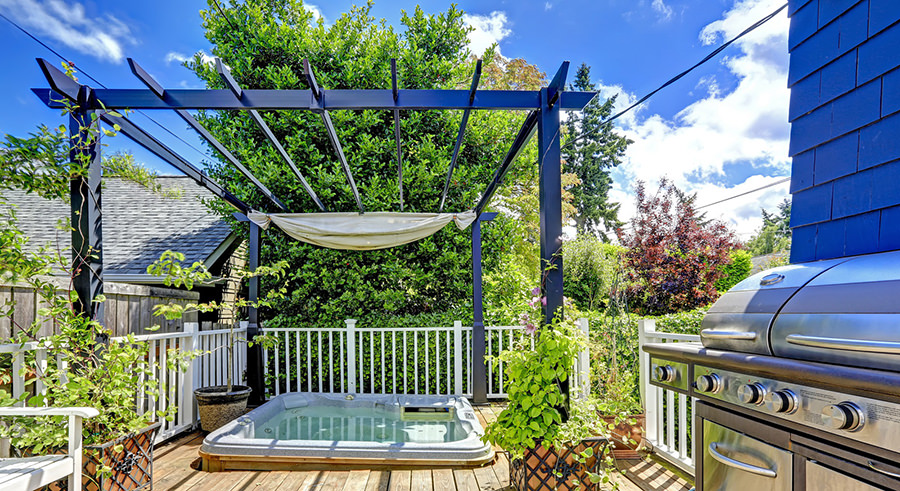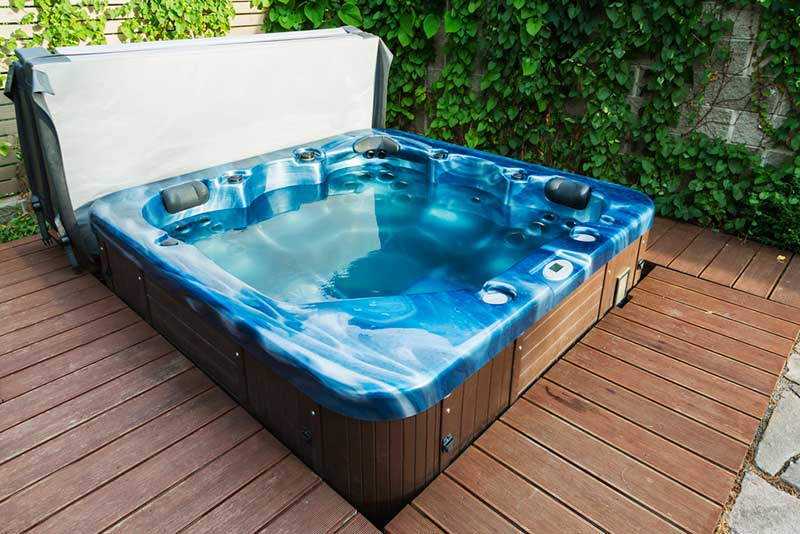
An inflatable hot tub is the perfect way to enjoy your garden this summer, but you need to make sure that you put it on the right type of base to avoid problems. There are several different options when it comes to finding the right base for your inflatable spa, but how do you choose the right one for your needs? I thought I’d look into the different possibilities to learn the pros and cons of each.
So, what is the best base for an inflatable hot tub? Inflatable hot tubs can be placed on a wide variety of surfaces, but some of the best include concrete, grass and decking that has been suitably reinforced if necessary.
Remember that a hot tub full of water and bathers is extremely heavy and can cause damage or injury if it isn’t placed on an appropriate surface. The weight of the hot tub could cause structural damage to your property and there is a possibility that you could injure yourself getting in or out of the hot tub on the wrong type of surface.
Read on to find out how to avoid the most common pitfalls.
What Type Of Base Is Safe For Use Under An Inflatable Hot Tub?
When it comes to finding the right base for an inflatable hot tub, safety is one of the primary concerns. You need to be certain that anyone using the tub won’t slip and fall when getting into or out of the water. You also need to be sure that the base is strong enough to support the full weight of the tub itself as well as the water and the people inside it.
An inflatable hot tub can be surprisingly heavy. While the tub itself weighs relatively little since it is only made from light vinyl and it is filled with air, once you add the water to it and then add two, three or four bathers you could be looking at a fairly hefty load that needs to be supported.

Not only is there a significant amount of weight to be supported, but all of that load is directed on a very small footprint. This is why having a very supportive and strong base that will not break up or move under the strain and weight is imperative.
For example, if the tub is placed on raised decking, it will have no difficulties in supporting the inflatable tub itself. However, when the water is added, it may find the additional strain too much. When a few bathers get into the water, there is a serious risk of the decking breaking under the weight. This would, clearly, not be very safe.
That isn’t to say that raised decking is an unsuitable base for an inflatable spa, but the right reinforcement measures need to be taken to ensure safety.
The best types of base are strong, sturdy and even, especially if you’re planning to put the hot tub on there on a permanent or semi-permanent basis. Something that needs to be considered in the case of an inflatable tub is possible damage to the bottom. The vinyl can easily be punctured by rocks or stones underneath the base, and this can cause the tub to leak or become unusable. Therefore, finding a flat surface without any potential puncture hazards beneath is the best solution.
Some of the best options for use under Inflatable Hot Tubs include patios, terraces, and concrete surfaces. These are all flat, sturdy, strong, supportive and even – ideal for taking the weight of the tub itself plus the water and users.
Is My Patio Suitable For An Inflatable Hot Tub?
If your property already has a patio outside, this could be the ideal place to put your inflatable hot tub. You do need to ensure the patio is properly laid, level and secure though. It also has to have a strong foundation. Many basic patios and garden terraces have simply been laid on sharp sand with just a small amount of cement to secure them in place.

This approach is fine if you’ll only sit on the patio or put a few tubs of plants on top of it. However, if you’re putting a hot tub full of water and bathers on top of it, a patio or terrace laid on top of sharp sand probably won’t be sufficiently stable to support the entire weight. There’s a good chance the slabs of the patio will shift under that weight and could possibly crack. This could lead to a number of problems.
It’s therefore important to ensure that any patio or terrace on which you intend to put an inflatable hot tub has strong and well-built foundations. Ideally, it should have a base made from hardcore to ensure more resistance to weight and greater strength. Any slabs or tiles should be sufficiently thick as well as cemented firmly in place. They should also be completely level to ensure the best possible base for your hot tub.
Can I Place An Inflatable Hot Tub On Concrete?
While concrete slabs aren’t especially attractive, they’re ideal in terms of both security and strength for use under your hot tub. The concrete must be a minimum of six inches in thickness and, when possible, reinforced with steel. Although this sounds complicated, it should be easily done yourself if you follow an online tutorial and it isn’t too costly to accomplish.
If you’re planning on putting your hot tub on top of a concrete base, you need to ensure that the slab is bigger than the hot tub’s footprint. It needs to be several inches larger all around its circumference. Also, since the slab will, most likely, be raised up above the level of the ground, you’ll need to think about blending it effectively into the surroundings.
This isn’t just important for aesthetic reasons but also for safety – you don’t want to accidentally trip and fall when getting into or out of the tub. One way to blend the tub into the surrounding area is to create an even bigger concrete base before tiling around the surrounding area. A concrete slab could also be the basis of a larger raised terrace or patio, or you could even create a deck surrounding it.
There are numerous options that you could go for when it comes to concrete bases, and all can form an excellent and sturdy solution for siting your hot tub in your outdoor area.
Is My Decking Unsuitable For Placing A Hot Tub On?
Decking is one of the most popular choices when it comes to making outdoor spaces aesthetically pleasing, but if you’re wondering whether yours is suitable for siting your inflatable hot tub on you need to bear a few more things in mind.
The average decking isn’t built to take the heavy weight of a full hot tub, even an inflatable one. This means you need to take a few additional steps to make your deck suitable. There are two main options here:
The first option is to put your hot tub on the decking but to place reinforcements under the decking below the tub area.
The second option is to construct a concrete base beneath the tub, or make a support of bricks and mortar below the area where you plan to place the hot tub. This will allow you to stand the inflatable tub safely on a sturdy and strong surface while you rebuild or construct the decking around it.

Should you wish to reinforce your existing deck you may need to obtain some expert advice or get help from a professional. It’s possible to reinforce the existing joints and use bigger wooden joists to support the deck frame, but if the foundations aren’t suitable to take the extra weight your deck will still fail.
It’s often best to construct a solid base of brick and concrete under the tub then to build decking around it. This will guarantee that your hot tub has been placed on a highly secure foundation, with the deck only needing to support the people who sit and walk around your spa.
If you are in any doubt about your deck’s strength or how to go about reinforcing it then you need to consult a qualified engineer or builder to help you make the deck safe and strong enough for your hot tub to stand on.
What Is A Hot Tub Pad And Do I Need One?
The hot tub pad is a relatively new invention but it has become quite a popular option for those who have both inflatable and standard hot tubs in their outdoor spaces. They represent an excellent solution for anybody who doesn’t have a base that is suitable in their garden and who doesn’t want to have to put in any extra effort in creating a permanent base of bricks and mortar or concrete.
This is especially the case when it comes to finding a base for an inflatable tub that will only be used occasionally or during the summer season.
Hot tub pads are a convenient and simple way to create a suitable base for underneath your hot tub. These pads are, essentially, interlocking tiles that have cavities which are fillable with pea shingle or gravel. To begin setting up a hot tub pad you must dig a level and shallow space in the ground where you wish the pad to be placed.
You then need to lay the tiles, interlocking them together until you have created a large enough area on which to place your hot tub leaving just a small amount of additional space surrounding its edges. Once this has been done, you can fill in the gravel or pea shingle, compacting it thoroughly to produce a firm, level and strong base.
Hot tub pads come with a major advantage, though, that a patio, concrete slab or reinforced deck does not. It can be relatively easily relocated and moved – something that just isn’t possible with bricks or concrete.
You can also purchase pads ready made online that are ideal for placing beneath a hot tub. Make sure to check the amount of pressure and weight per square foot that they are capable of taking before you buy.

Related Questions
Can I place my inflatable hot tub on my grass? If your outdoor space is entirely grassed you may be wondering whether you can put your inflatable spa directly onto it without having to worry about making a concrete base or installing some decking.
Grass is a popular choice of surface under blow-up hot tubs and it’s technically possible to use yours on your lawn if you aren’t planning to leave your tub inflated and in permanent use. If you’re only going to be using your inflatable hot tub occasionally and won’t be leaving it in place all year round, it’s perfectly fine to place it on the grass for short periods of time.
However, there are a few considerations to keep in mind. Firstly, if you’re planning to leave your tub on the grass for several days or weeks you can expect some damage to occur to the appearance of your lawn. In the best case scenario, the colour of the grass may change. In the worst-case scenario, you may find that you end up with a bare patch where the tub has been when you finally come to deflate it and pack it up for the winter season.
You also need to consider whether there are any potential puncture hazards on the surface that could cause damage to the base of the tub. Even a small amount of broken glass, a few sharp stones, or a pointed stick could cause damage to the vinyl bottom of the tub resulting in leaks or even in the tub becoming unusable.
Also, while grass is a good cushioning material that makes the hot tub more comfortable to sit in, it isn’t a good insulator. Therefore, if you’re placing your hot tub directly onto your lawn you should place an air mat or ground cloth underneath it. This will not only help to keep the heat inside the tub but it will also offer a little extra protection from punctures and damage.
Where Should I Put My Inflatable Hot Tub In My Garden?
The best place in your garden to put your hot tub will depend on the shape, size and orientation of your outdoor space. It goes without saying that choosing a space that is relatively close to your house is the best option to allow for easier access. It also makes sense to choose a sheltered and private spot so that you won’t be overlooked by your neighbours or passers by.
Also, if you choose a spot that is away from cold draughts and prevailing winds you won’t need to spend so much money on heating the water and maintaining it at a comfortable temperature. If you can, find a spot that is near a wall or fence so that the wind won’t be able to blow so easily over the surface of the water causing evaporation and cooling. If you don’t have any sheltered spaces in your garden, you could consider creating a natural windbreak with plants, large shrubs or trees, even in pots if necessary, to protect from the wind.
Alternatively, there are even large gazebo-style structures that can be purchased online and set up over the hot tub to protect it from cold and windy conditions and which allow you to get more use from your hot tub even during the autumn season. Another factor to keep in mind when placing your inflatable tub in your garden is that it will need to be close enough to the power outlet to enable it to be connected to your home’s electricity supply without needing to use an extension cable.
Extension cords are not suitable for use with hot tubs so this is something to remember. Also, you will need to ensure that you can reach a hose between the tap and the hot tub in order to fill it and drain it. This means you will need to choose a site that is relatively close to the water source. Although an inflatable hot tub can be moved easily when it’s empty, it’s impossible to move when it’s full of water so you’ll need to choose the correct spot before you fill it up ready for use.
Do I need to keep the pump in mind when I’m choosing a place to place my inflatable hot tub? All hot tubs have a pump, including inflatable spas. The location of the pump is a key consideration when you’re choosing where to put your hot tub in your outdoor space, especially if you want to keep your tub in position for an extended period of time.
If you’re going to be filling your hot tub and leaving it in place throughout the summer season, you need to ensure that you’ve chosen the best spot first time since you won’t be able to move the tub without draining it first.
Therefore, make sure that the pump is in an easily accessible spot so that you can get to it easily without having to move the tub or drain it. You should be able to walk around the tub easily once it’s in its final position. Also, bear in mind that if the pump is too close to a wall it will cause the sound that the pump makes to appear louder.
If your hot tub has a relatively loud-running pump anyway, choosing a site that is close to a fence or wall will only exacerbate the sound.

